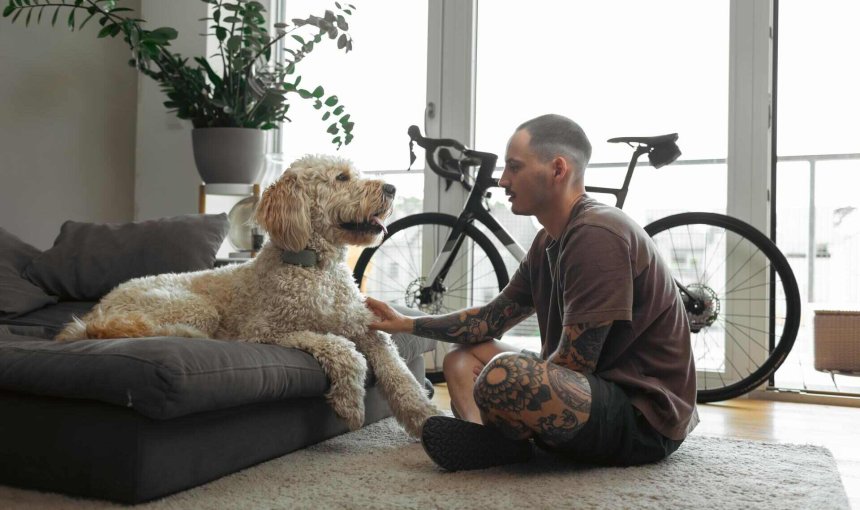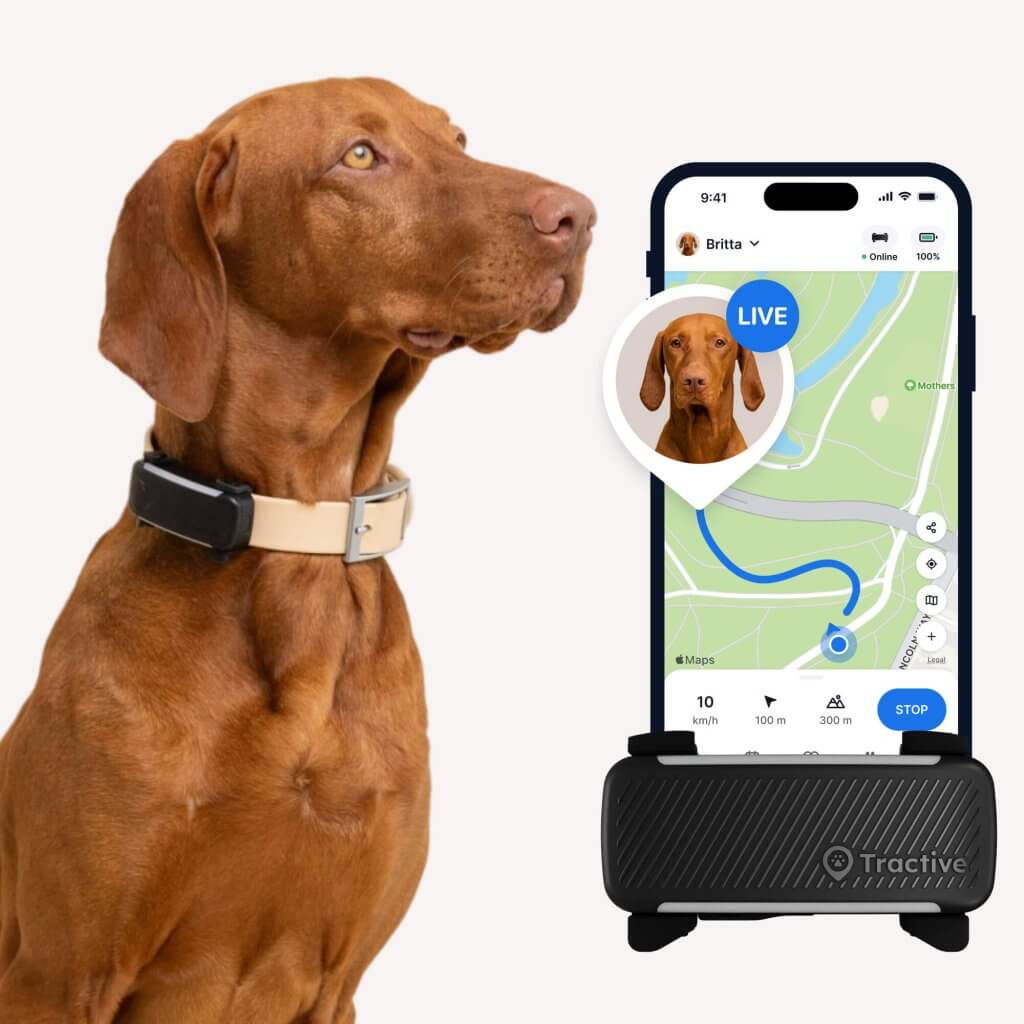Therapy Dogs: Who They Are & What Do They Do
Therapy dogs are specially trained canines who provide comfort in care settings around the world. But how else do they benefit us? And how are they different from service & emotional support dogs?

In a world full of stress and challenges, our furry friends can make all the difference. So if you’ve ever run into a Golden Labrador or a Great Dane at a hospital or senior care home, chances are they’re volunteering their time there as a therapy dog. But what are therapy dogs? And what do they even do?

Always know your buddy is healthy & safe
Read moreWhat are therapy dogs?
Therapy dogs are specially trained canines that offer support and companionship to people in care settings. These might include:
- Hospitals
- Rehabilitation centers
- Nursing homes
- Areas afflicted with disasters
- Schools, especially where students have learning disabilities
These dogs provide a unique kind of care through their presence and interactions. They bring a comforting, unconditionally loving presence to facilities where patients might be recovering from injury or trauma, and might be feeling lonely or anxious. They also provide solace to family members who might be grieving a loved one. They’re especially popular in pediatric wards, where children who are recuperating from disease or injury feel cheered up at the sight of a friendly dog.
Because of their role, therapy dogs must be well-equipped to navigate diverse environments. They should also be able interact with a range of different people with different needs. As a result, some dogs might be better suited to this role as a result of their temperament. (We cover a few of these below.)
Ideally, therapy dogs are:
- Friendly and sociable by temperament
- Comfortable being surrounded by and interacting with different people
- Attuned to the needs of people in care settings
- Able to cooperate with hospital or care home staff
- Able to easily adapt to new environments
- Pliable to their handler’s instructions
Are therapy dogs the same as service & emotional support dogs?
No, therapy dogs aren’t the same as service and emotional support dogs. Here are some key differences in their roles1:
- Service dogs are specifically trained to perform tasks for one person who has a specific disability. They’re protected under the Americans with Disabilities Act (ADA) in the US and can access a number of public places. These might include places dogs aren’t usually allowed in, like flights and public transport.2
- Emotional support dogs are usually prescribed by a mental health professional to support the treatment of one person who’s experiencing mental health difficulties. They’re not protected by the ADA in the US and might not be allowed in certain public places (like libraries or airplanes.)3
Therapy dogs, on the other hand, address the needs of multiple people across different care environments. They’re specifically trained to offer a comforting presence to groups of people. And like emotional support dogs, they’re not protected under the same legal standards in the US. So they might not be allowed in areas like restaurants or other public places.
What do therapy dogs do?
Therapeutic visitation dogs
These dogs visit hospitals, care homes, rehabilitation centers, and more – all places they can provide a gentle, comforting presence to patients, residents, and students. They might be household pets whose parents take time to visit these facilities and help brighten their day.
Animal-assisted therapy dogs
These dogs work closely with healthcare professionals in therapy settings. They’re part and parcel of therapy sessions to help individuals achieve their goals. Physical, occupational, and mental health professionals use the support of therapy dogs as a part of their sessions. Animal-assisted therapy dogs might also work in rehabilitation facilities.
Facility therapy dogs
Facility therapy dogs work specifically in places like nursing homes where residents might suffer from diseases like Alzheimer’s disease or other mental health difficulties. They usually live on the premises with a trained member of the staff.
Crisis response therapy dogs
These specialized working dogs provide emotional support to survivors and responders. Their calming presence can help reduce stress and anxiety during these kinds of challenging, life-threatening situations. As a result, crisis response therapy dogs must not be afraid of strangers or crowds or loud noises like crying or screaming – but must also be trained and socialized.
Do therapy dogs “work”?
While therapy dogs add immense value to our lives, they aren’t considered to be at “work”. (Unlike service dogs or other kinds of working dog breeds.) Legally, only the intense training and tasks that most service dogs go through qualify them as “working” dogs.
Therapy dogs, on the other hand, might go through basic good behavior training. But because they mainly provide comfort through their presence, it doesn’t qualify them as “working” dogs the same way as service dogs. As a result, therapy dogs aren’t protected under the Americans With Disabilities Act (ADA).

Keep track of your dog’s daily adventures
Follow every step with unlimited range Live Tracking. Get alerts if they wander too far. Keep them happy & healthy with Activity & Sleep Monitoring. Get Health Alerts if something seems off.
How therapy dogs add value to care environments
Therapy dogs bring a ton of benefits for the people they interact with. Besides just warmth and comfort, here are some of the advantages a therapy dog brings along:
Improved physical symptoms
The presence of a cheerful dog can help reduce cortisol, the stress hormone, and make patients feel happier and more relaxed instead. This in turn can help reduce their blood pressure and heart rate, as well as their anxiety.6
In fact, some studies have even found that children working on a stressful task tend to feel more positive about it when their pet dog or a therapy dog is around.7 (As compared to a parent – or even a stuffed dog.) These dogs also have a positive impact on children with attention deficit hyperactivity disorder (ADHD), who might find it difficult to regulate their emotions.8
Improved emotional wellbeing
With their affectionate, playful natures, therapy dogs can bring smiles even on challenging days. As a result, their presence can help increase patients’ oxytocin and endorphins – which can also ease recovery.9
Interacting with dogs can also help patients regulate their emotions better when facing stress. In fact, some studies have found that the presence of a dog during psychotherapy can reduce distress in patients who’ve experienced trauma.10
Reduced social isolation
Healthcare facilities can be lonely, isolating places. Patients often miss their families and loved ones when institutionalized. Like in the studies from the 1970s, therapy dogs can help them feel less lonely, converse more easily with the people around them, and connect with each other more easily.11
Improved learning & cognition
Therapy dogs play an important role in schools too. Research suggests that even spending short periods of time with one can help children improve learning and cognitive skills. For example, some studies found children’s reading performance improved when they read to a dog.12 Others found that spending time with a therapy dog improved children’s speed in motor and cognitive skills, like in memory games.13
Certifying and training a therapy dog
If you have a dog who’s friendly and loves people, you might be wondering if they could count as a therapy dog. However, therapy dogs do need to be certified by and registered at a reputable national organization like Pet Partners14 or Therapy Dogs International.15 And to get certified, your dog would need to go through training and various assessments to gauge whether it’s the right temperament and fit for care settings.
For example, all therapy dogs must have basic training and be well-controlled in terms of their behavior. In some cases, they might need to pass the American Kennel Club (AKC) Canine Good Citizen Test which helps all dogs learn basic good manners and how to interact with people and other dogs.16 As a result, therapy dogs must learn to remain calm, gentle, and obedient in various situations so that they can adapt best to the dynamic nature of their role.



